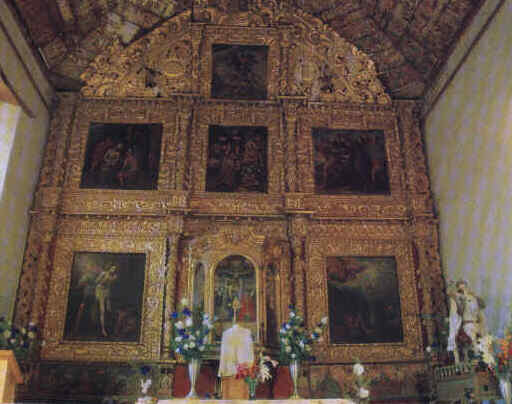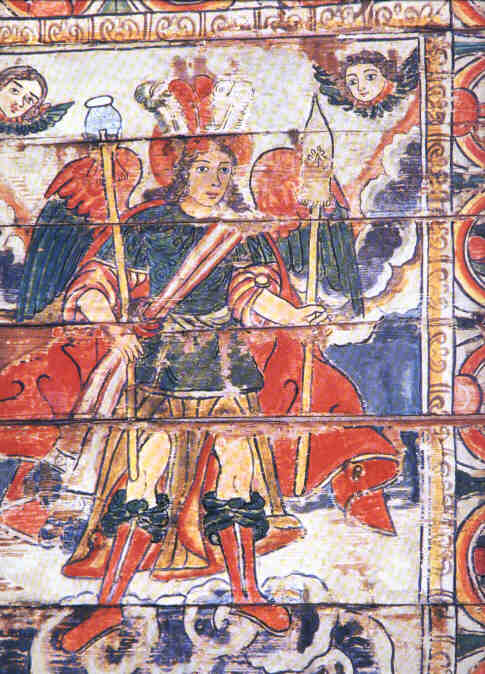Did You Know…?
A small church with a rather nondescript exterior in a tiny village (Tupátaro) just off the main highway between Morelia and Pátzcuaro hardly sounds like the kind of place where you’re likely to find one of Latin America’s artistic masterpieces, but initial appearances can be very deceiving.
The whitewashed exterior of Tupátaro’s church may be plain, but its interior is richly decorated and absolutely breathtaking. The present church, thought to date from the eighteenth century, is dedicated to Santiago Apostol (St. James). It houses several outstanding artistic treasures.
Near the entrance is the life-size El Cristo de Cuanajo, made of cornpaste (pasta de caña de maíz) in the style typical of the Pátzcuaro region.

The church’s elaborate gilded retablo (the altarpiece behind the main altar) dates from 1761 and includes paintings depicting Christ’s Passion, carvings of pelicans (a symbol of Christ’s sacrifice) and a painting of the Three Kings, besides another panel depicting the village’s patron saint.
One of several unexpected surprises that emerged during restoration work carried out in the church in the 1980s and early 1990s by Enrique Luft is the fact that the eighteenth century altar table is entirely covered with silver leaf.
But, by far the most remarkable feature of the church is its magnificent painted wooden ceiling. Only a small number of churches in Mexico still have artesonado ceilings, and almost all of them are located in Michoacán. Artesonado ceilings are apparently of mixed Arabic / Spanish ancestry. The name derives from the similarity of their shape to a gigantic upside-down artesa or wooden trough. This particular artesonado ceiling is vividly painted, in its entirety, with panels illustrating the Life and Passion of Christ; there are 42 panels in all and the effect is awesome.

The central section (dated 1772) of the ceiling depicts well-known incidents in Christ’s life like the Last Supper and the Ascension. The side panels display Archangels in all their glory. Details include cherubs, miniature portraits, fruit, superb headdresses… Various different dates, ranging from 1725 to 1793, are found on the supporting crossbeams, suggesting that the ceiling took several phases of work to complete.
The pigments used in the paintings, derived mainly from vegetables and insects, are reds, blues, greens and browns. The indigenous artists responsible for all this elaborate work remain anonymous, but their masterpiece is one of the finest examples of what has come to be known as the Popular Mexican Baroque style.
Lovingly restored, this colonial gem is now looked after by INAH, the federal institute for anthropology and history. A resident INAH custodian is on hand, whenever the church is open, to switch on the soft lighting artfully positioned so as to reveal most of the incredible details of the paintings. The custodian is also prepared to provide some explanation (in Spanish) of both the techniques used and the subject matter chosen by those enterprising indigenous eighteenth century “Michelangelos” of the New World.
The church attracts some 16,000 visitors a year. Admission is free, but donations to INAH are accepted. Opening hours are 10 a.m. to 5 p.m., Tuesday to Sunday (closed Monday).
How to get there / Where to stay:
Tupátaro is about 4 kilometers south of the major divided highway (federal highway 14) that links the town of Patzcuaro to the city of Morelia, the state capital of Michoacán. The side road to Tupátaro is signposted about 50 kilometers west of Morelia or 15 kilometers east of Pátzcuaro. The village of Tupátaro has no tourist services. Incidentally, the village’s name, Tupátaro, means “place of reeds or bulrushes”, plants that still thrive in profusion today on the shores of nearby Lake Patzcuaro and are widely used in making modern handicrafts. Consider combining your visit to see the “Sistine Chapel of the Americas” with some serious purchasing of wooden hand-made crafts and furniture in the nearby village of Cuanajo. For those wanting to stay overnight, Pátzcuaro, with its rich Indian heritage, has excellent hotels and restaurants and is an excellent base from which to explore the fascinating countryside round about. Alternatively, Morelia, which enjoys “World Heritage” status, is a large and lively city. It also has the full range of excellent tourist services and is about 50 minutes driving time from Tupátaro.
Reference / Further Reading:
Many of the details in this article are based on Richard Perry’s authoritative account of colonial religious architecture in the region, “Blue Lakes and Silver Cities; The Colonial Arts and Architecture of West Mexico” (Espadaña Press, 1997). The book can be ordered on-line from Sombrero Books. Some additional historical information (regrettably without pictures) is included on INAH’s web-site
The illustrations accompanying this article are from a poster supplied by the Tourism Secretariat of the State of Michoacan.
Copyright 2002 by Tony Burton. All rights reserved.

